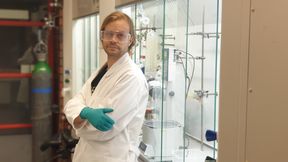Assistant Professor Juha Siitonen always wanted to be a chemist

Siitonen was roughly four years old when he told his parents that he wanted to become a professor when he grew up. Even as a child, he conducted various chemical experiments in glass jars, using substances found in common grocery stores. By secondary school, Siitonen had already assembled a relatively large home laboratory, and by the end of upper secondary he had studied university chemistry extensively and carried out university-level practical work independently with his own equipment.
Before taking up his current position, Siitonen worked for three years as a postdoctoral researcher and university lecturer in organic chemistry at Rice University in the US. Siitonen now leads the Experimental and Theoretical Organic Synthesis (ETOS) research group at Aalto University.
‘We study synthesis, the science of making stuff. Almost all substances used in modern society, from plastics to pharmaceuticals, have gone through some form of chemical transformation. In fact, all our modern technology depends on our ability to make molecules,’ says Siitonen.
The ETOS research group continues Aalto University's long tradition of working on the total synthesis of natural products. One of the previous holders of the professorship, Professor Gustaf Komppa, developed the first total synthesis of Camphor in 1903. This achievement is considered the world's first synthesis of a truly complex natural product.
Looking for new, ingenious ways to make molecules
Natural products are molecules isolated from nature, they are individual organic compounds produced by organisms as toxins for self-defense or, for example, as dyes. We come into contact with such natural products every day, for example in the form of caffeine, the alkaloid found in coffee beans.
Siitonen mentions that about half of the medicines and many of the materials we use are natural products that we have slightly modified or used as such because evolution has refined them to work very effectively over billions of years.
‘Biologically active molecules are isolated in extremely small quantities from nature and their structure is therefore known accurately. The challenge for synthetic chemistry is then: can we make a copy of such a molecule in the laboratory so that we can produce sufficient quantities of the compound and its derivatives for further research? Because these molecules have very complex chemical structures and they have important applications in medicine and materials science, we synthetic chemists use them as research platforms for discovering new chemistry,’ says Siitonen.
According to Siitonen, the current tools for making molecules are so sophisticated that basically any molecule can be made, given enough time, money and resources. The problem, of course, is that we cannot burn through resources at the current rate. Therefore, chemists have to come up with more ingenious ways of doing things.
‘Could we, for example, design the whole manufacturing process so that instead of ten chemical reactions we only need two? Or could we develop reactions that form the desired molecule in a single step, all at once, from very cheap and simple starting materials? It is at this level that we are trying to solve the problems of manufacturing molecules.’
Towards a thorough understanding of how molecules work
In addition to chemistry Siitonen is also interested in mathematics, physics and programming. This broad interest in different disciplines has proven highly useful for his research.
As an example, Siitonen cites a familiar illustration from school, showing a starting material A, reaction product B and a reaction arrow that connects them to describe the creation of a new compound.
‘What's actually happening inside the arrow? Our research group's goal is to try to understand how molecules interact in chemical reactions, why substances react with each other in a certain way. The new compounds that form in a reaction don't just somehow appear out of thin air – the starting materials interact with each other in a quantum mechanical way. And in order to rationally design reactions for molecules, you need to be able to apply tools from physics, such as quantum mechanics and thermodynamics,’ Siitonen says.
Since childhood, Siitonen has also had a tendency, perhaps typical of an engineer, to dismantle devices and appliances to find a deeper understanding of how they work. To this day, he designs and builds electrical equipment for synthetic chemistry research and to support his teaching.
‘Basically, we do the same thing in chemistry, where we break down the reactions between molecules and use quantum chemical computations on supercomputers to model what those substances actually do, what kind of events are possible. And we can then use the understanding from those models to inform the experimental synthesis design process.’
Developing problem-solving skills is at the heart of learning
Siitonen urges students to think about the deeper meaning of their university studies, especially the social aspects. Why do we have a university in the first place? And what is its purpose for the student and the student community?
‘In universities, we can solve and ponder on problems that are so difficult that they probably would not be solved elsewhere. These solutions can then be used as a basis for applied research. When students graduate from us and go to work in, say, the pharmaceutical industry, they are the experts to turn to when there's a problem no one else can solve.’
According to Siitonen, one of the most important benefits of university studies is the development of versatile problem-solving skills, especially in group situations. It is important that students learn to break down complex problems into parts, analyse them in different ways and understand their wider context.
‘It is important to learn to approach problems that seem complex as interesting challenges rather than as insurmountable obstacles. It took me a long time to develop such confidence as a researcher and I now want to actively guide students towards such a mindset. Nowadays, if I come across a problem that I can't solve at all at first, I view it as a fascinating challenge. And often, if you just systematically study the problem together with others and consider it from different angles, you will find a solution.’
Who?
- Doctor of Philosophy (University of Jyväskylä, 2018), Assistant Professor of Organic Chemistry at Aalto University School of Chemical Engineering.
- Prior to Aalto, he worked for three years at Rice University in Texas as a postdoctoral researcher and university lecturer in organic chemistry.
- Active in the visual arts – draws, paints and reads books on art history. Interested in the interface between the worlds of science and art. Other hobbies include running and electronics design.
- Published:
- Updated:
Read more news

Broadband miniaturized spectrometer research receives QTF annual discovery award 2024
The clarity and compelling presentation of the research were one of the reasons why Doctoral Researcher Md Uddin earned the prize for the research paper, which was published in Nature Communications.
Robotics needs safe behavior patterns
Robotics and autonomous systems are developing rapidly. Algorithms that withstand disturbances and uncertainties in the system model and environment are critical for development.